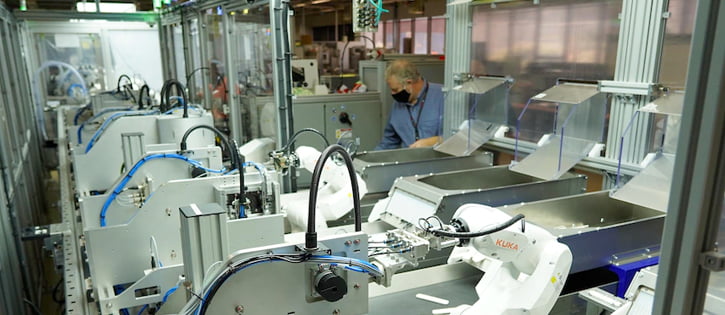Bosch Australia is no stranger to adaptation.
Key points:
- Manufacturing production rose 0.9 per cent in the June quarter GDP, taking annual growth to 9.6 per cent
- $4.8 billion was spent by the sector in research and development in 2020/21
- The current lockdowns have sent growth backwards
It used to be a key supplier of parts and assembly lines for Australia’s car-making sector.
But when that industry was shut down last decade, it pivoted.
A word we’ve all become accustomed to since COVID-19.
“We were left with a very talented team of engineers who were very well versed in manufacturing and production engineering and we decided at that time to take that skill set externally and work with other customers,” Peter Hook, Bosch Australia Manufacturing Solutions general manager, said.
The team started making parts for other industries that have really come to the fore since the pandemic.
“The medical device industry, the biotech industry have very similar needs and requirements as the automotive industry with its very high dependence on quality or high dependence on safety,” Mr Hook said.
They’ve been pivoting again, just like their clients.
Bosch had been working with Ellume to make at home flu testing kits but they quickly adapted those to at-home COVID-19 testing kits.
“We’re building a number of production lines for them which are going to be delivered to their Brisbane facility and also into the United States,” said Mr Hook.
Will the manufacturing boost last?
It’s been that rapid change, and a desire to shorten supply chains, that many hoped would boost Australia’s manufacturing sector after the pandemic.
Until the latest lockdowns, it was growing exponentially.
Analysis by IHS Markit for its Manufacturing Purchasing Managers’ Index shows, after the initial shock of the pandemic last year, manufacturing grew at its fastest pace in five years, until May this year.
The growth has been in sub-sectors like medical technology, space, robots and food and beverage.
In the June quarter GDP figures, manufacturing production rose 0.9 of a per cent taking annual growth to 9.6 per cent.
But the current lockdowns put a sudden stop to that trajectory and have sent that growth falling.
“The extension of COVID-19 restrictions into September continued to dampen business conditions in the Australian private sector, although the slight easing of restrictions was picked up in the latest IHS Markit Flash Australia Composite PMI, seeing the overall Composite Output Index contracting at a slower rate in September,” Jingyi Pan, IHS Markit economics associate director, wrote.
While supply-chain issues and labout shortages are starting to put cost pressures on Australian manufacturers, most remain positive about the outlook.
“The employment index, meanwhile, pointed to higher workforce levels, which was a positive sign following the decline recorded in August, driven by the severe COVID-19 disruptions,” she observed.
“Overall optimism amongst manufacturers nevertheless sustained in September, with business confidence having risen to the highest since June.”
Government’s helping hand
The government is incentivising growth in six areas of manufacturing: resources technology & critical minerals processing, food & beverage, medical products, recycling and clean energy, defence and space.
That is exactly what Sydney-based manufacturer Romar Engineering has done, 50 years after the business was created by husband and wife team Robert and Marion Wilson.
“Primarily we’re involved in the manufacture of medical devices but in recent times [we’ve moved] into the manufacturing of very high, bespoke equipment for the space industry,” chief executive Alan Lipman told The Business.
“A lot of the parts that we’re being asked to design and build from scratch are parts that can’t be sourced from overseas for various defence reasons.”
That pivot from a maker of products for the IVF industry to space parts has meant they have just been awarded $5.85 million from the federal government to create more technology for space.
“It’s a one for one so they’re providing us with $5.85 million over three years and we have to find our own $5.85 million in order to build this business out,” Mr Lipman said.
“It’s a very exciting time for a modern family business.”
Multi-billion-dollar investment
Even before the pandemic, investment to increase manufacturing was on the rise.
In the 2019/20 financial year, $4.8 billion was spent by the sector in research and development (R&D), making it the second-biggest contributor to R&D in Australia.
It accounted for 26 per cent of all R&D investment in 2020/21, according to data from the Australian Bureau of Statistics.
After four years of R&D, Perth company Nexxis has created ‘magneto’.
“It’s the next generation of robotics and it’s designed for hazardous area inspections in the confined space industry,” said Nexxis founder and managing director Jason De Silviera.
The spider looking device has magnets on its feet, a camera on its body and is controlled by a gaming console.
“It carries out inspections where we shouldn’t be putting humans and it works using electromagnetics and ultimately it gets the information that inspectors need without [them] going inside,” Mr De Silviera said.
Nexxis is targeting the oil and gas sector that carries out regular safety inspections in dangerous and confined spaces.
“Testing can kind of start fairly soon and we’re really hoping early 2022 is when we should really start production,” Mr De Silviera told The Business.
Supply chain interruptions meant a lot of Australian customers have had to wait long periods for goods.
Mr De Silviera said that’s been a boon for local manufacturers who can deliver faster.
“For us to engineer and then design and then send it away overseas to then get it back and then modify, it doesn’t solve problems quick enough,” he said.
It’s that demand for fast solutions the sector hopes will put it back on its path of rapid growth when current lockdowns end.
SOURCE: https://www.abc.net.au/news/2021-09-23/manufacturing-rise-/100483082

